Sample costs and returns to establish a vineyard and produce wine grapes in northwestern Nevada are presented in this publication. This publication is intended to be a guide used to make production decisions, determine potential returns, and prepare business and marketing plans. Practices described are based on the production practices considered typical for a wine grape production in this region, but may not apply to every operation. The “Your Vineyard” column is provided in Tables 1 & 2 for your use.
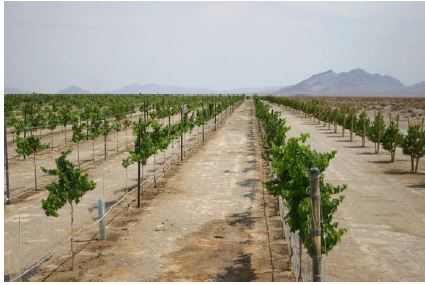
ASSUMPTIONS
The following assumptions refer to Tables 1 through 4 and reflect the typical costs and returns to establish and produce interspecific wine grape varieties in northwestern Nevada. The practices described are not the recommendations of the University of Nevada, Reno, but rather the production practices and materials considered typical of a well-managed farm in the region, as determined by a producer panel in April 2008. Costs, materials and practices are not applicable to all situations, as establishment and cultural practices vary among growers within the region.
Farm
The representative farm consists of 26 acres of land, on which 5 acres of wine grapes are established, 20 acres are devoted to other crops, and 1 acre is used for owner housing, machine shop, and roads. The minimum land market value in 2008 was approximately $11,500.00 per acre for agricultural land in northwestern Nevada with water rights.
Establishment (Years 1-3)
This vineyard is established on ground previously planted to alfalfa. The land is assumed to be fairly level, although hillsides with a 3 percent to 6 percent slope are preferred; hillside plantings extend the growing season by 5 to 7 weeks and reduce the chances of severe late spring frost damage by up to 80 percent. The establishment year consists of 3 years. Establishment year costs are provided in Table 1.
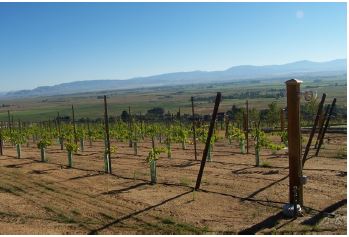
Land Preparation
In September, prior to the planting year, a custom operator removes vegetation from the site by spraying the existing crop with Roundup* or other herbicide and cross rips or chisels the plot to 4-6 feet deep in the vine rows to break up the hardpan at a cost of $750 per acre. The plots are then disked by the owner. The soil should be sampled and sent to a laboratory for analysis. Three samples are taken from each acre at a cost of $98 per acre. If needed, elemental sulfur is added to reduce the pH of the soil; to reduce sandy soils from a pH of 8.5 to 6.5 requires 2000 lbs. of sulfur at a cost of $200 per acre. Additional micro-nutrients are added based on the recommendations of the soil analysis report. All operations that prepare the vineyard for planting, whether they are done in the same year as planting or done in the previous year, are shown in the first year costs.
Trellis System
A commercial company installs the trellis system in spring of the first year. Trellis design is dependent on the variety of interspecific grapes that are being grown. For those grapes with an upward growth pattern such as Brianna and Marquette, the trellis system is a vertical six-wire design for Vertical Shoot Positioning (VSP). Trellis materials include 2’x 3/4” earth anchors, 12 gauge guide wires to connect the anchors to the end posts, 9 foot steel channel end posts with grippler tensioner devices driven 3’ into the ground at an angle, 8-ft V-posts every 24 feet along the trellis driven 2’ into the ground, 4’ grape stakes placed 6 feet apart in between the V posts and 1’ into the ground, a single 12 gauge vertical cane support wire placed at 3 ½’ above ground and double 12 gauge vertical cane support wind wires two inches apart placed at 4 ½’ and 5 ½’ above ground. Also a 12-gauge wire is strung at 18 inches above ground to hold the drip tubing. For trailing varieties of grapes with a downward growth pattern such as St. Croix, Frontenac, La Cresent, or La Cross, a Top Wire Cordon (TWC) trellis system is preferred. This system is like the VSP system with the exception that between the V posts are 8’ grape stakes instead of 4’ and the only support wire is placed at the top of the system at 5 ½’ to 6’ above ground. Trellising needs to be extremely durable and strong, as a typical 600 foot row of vines could carry over 1 ton of weight and have a wind mass area of 3000 square feet. The average cost for installation and materials is $7 per vine with a per acre cost of $5,628, or $28,140 for the five acre plot.
Vines
No specific variety is used for this study, but the data refers to interspecific wine grapes, which are bred for use in climates like that of northern Nevada. The vines are purchased as two year old dormant vines at a cost of $4 per vine. Only certified disease resistant OWN ROOTED vines should be used, as T-Bud or Field Bud grafted vines will not survive northern Nevada winters; the graft union will crack and get infected with crown gall after several years in the field. The life of the vineyard at planting is expected to be 35 years and the grapevines are expected to begin yielding fruit in the third year, although the first harvest yield is calculated at 1.62 tons per acre, one-fourth of the harvest yield at maturity. Yield price is estimated at $825 per ton.
Planting
In mid-April, holes are dug and the vines are planted and protected with vented grow tubes placed over the vine. The vines are planted on a 6 x 9 ft (vine x row) spacing at 807 vines per acre. Interspecific losses are typically 2 percent or less so there is usually no need for replanting.
Training/Pruning
Training and pruning to establish the vine framework will vary with variety and trellis system. Training includes tying, shoot positioning and pruning. Unilateral or bilateral cordon training and spur pruning is the selection of the main shoot and its upper laterals or branches that form the trunk and cordon. They are tied to the stake and cordon wire while unwanted shoots are removed, including any suckers arising from the rootstock. Quadrilateral cordon training requires the addition of cross arms. Dormant pruning begins in April of the second year to stunt growth and potentially delay bud break past the last spring frost period. The young vines are pruned back to a 2-bud spur. Cordon training is done twice a month in June and July. In the third year, shoot positioning is done in June, July and August.
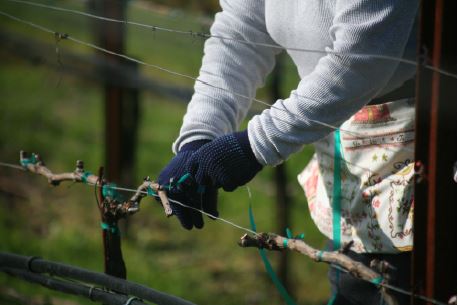
Irrigation
Irrigation is critical to the health and well-being of the vine, both during the growing season and in the dormancy period. The vineyard is irrigated by a drip system separated into six circuits. Drip irrigation lines are hung from the bottom trellis wire, and one, two-gallon per hour emitter is installed on each side of every plant. The vineyard is irrigated with a regulated deficit irrigation regime based upon plant water status and the amount of organic matter in the soil. In addition, the vineyard is given a deep watering of 16 gallons per plant at the beginning and end of every growing season to ensure normal bud and flower development after a long dry winter and sufficient carbohydrate reserves before entering dormancy, respectively. A total of 0.355 acre-feet of water per acre per season is applied on average. The irrigation source is assumed to be an existing well and pumping costs are estimated at $4.50 per acre inch; an additional $0.50 per acre inch is added to allow for flushing lines. Lines are checked with an ATV at each irrigation. Total irrigation costs for 4.26 acre inches of water are $21.30 per acre for those producers with agricultural water rights. If municipal water is the water source, irrigation costs could be as high as $170 per acre per season.
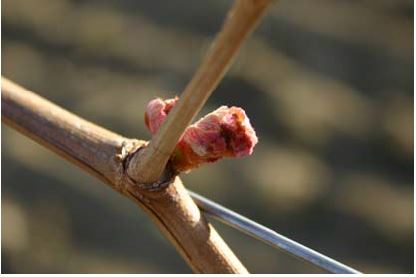
Frost Protection
Cold temperatures and frost can cause observable injury to grapes. However, the use of sprinklers or misters for frost protection is not recommended for locations in northern Nevada.
Pest Management
Due to the dry climate, wine production in northwestern Nevada faces fewer pest/disease problems than in California. A variety of pest management methods are used depending on pest population cycles.
Weeds
Weeds are controlled by the use of flail choppers and disking between the rows.
Insects
There is a tendency for vines in this area to become infested with white fly larvae in early spring. If treated with emulsified oil at the first sign of outbreak, epidemic populations can be avoided. One gallon of oil per acre is applied beginning the third year at a cost of $22.80 per acre.
Disease
The major disease in the area is powdery mildew. Wettable sulfur is applied in early April of the second year to prevent powdery mildew. In the third and subsequent years, wettable sulfur is applied twice in April and in May. The grower applies the sulfur from a tank mounted on the ATV at a cost of $16.50 per acre. In addition, infection with crown gall (Agrobacterium vitis) may be a problem due to cold weather, the solution to this is to plant OWN ROOTED vines.
Vertebrates
Beginning in year three, rolls of netting are placed over the vines to deter predation by birds.
Fertilization
The grower applies 10 pounds of nitrogen fertilizer as UN32* through the drip irrigation system in the spring of the first year only at a cost of $9 per acre. Additional nutrients are applied if indicated by results of soil sampling.
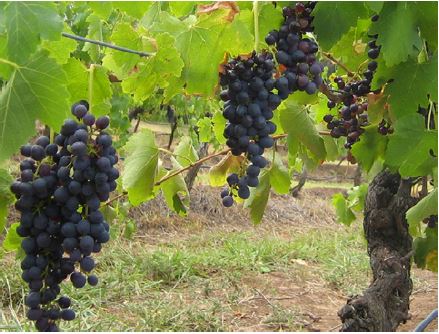
Production Cultural Practices and Material Inputs (Years 4-35)
Pruning
Pruning is done annually in April to stunt growth and potentially delay bud break past the last spring frost period and a second pass is made to tie the vines/canes. Prunings are placed in the row middles and disked into the soil to decompose. It is assumed that it takes 32 hours per acre to prune, 6 hours to tie and 4 hours per pass for suckering and positioning. Passes are made in May/June for suckering and positioning. Passes are made in June and July and August for shoot positioning, cluster thinning and some tying. Pruning time will vary with trellis type, variety and vine vigor.
Irrigation
The vineyard is irrigated with a regulated deficit irrigation regime based upon plant water status and the amount of organic matter in the soil. In addition, the vineyard is given a deep watering of 16 gallons per plant at the beginning and end of every growing season to ensure normal bud and flower development after a long dry winter and sufficient carbohydrate reserves before entering dormancy, respectively. Altogether, on average, 0.355 acre-feet of water per acre per season is applied at a cost of $21.30 per acre for those producers with agricultural water rights. If municipal water is the water source, irrigation costs could be as high as $170 per acre per season.
Frost Protection
The use of sprinklers or misters for frost protection is not recommended for locations in northern Nevada.
Fertilization
Soil and/or petiole (leaf stalk sampling) analysis should be completed the year prior to applications of synthetic or organic fertilizers to ensure vine nutrition and balance for the coming growing season at a cost of $50.00 per acre for petiole sampling. Nutrients are only applied if necessary after determination of nutrient status in the soil or plant.
Pest Management
Weeds are continued to be controlled by flailing and disking. Emulsified oil is applied for outbreaks of white fly larvae. Sulfur is applied to control powdery mildew and birds are controlled with netting placed over the vines.
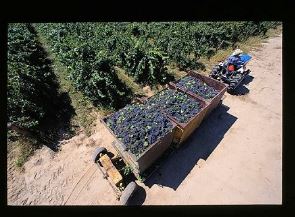
Harvest
The grower hires three or more workers to harvest grapes at a rate of $150 per ton. Each worker can harvest up to a ton of grapes in a day. One thousand pound picking bins which are rented for the season are brought down each row by a tractor pulling a bin trailer, and the pickers dump the grapes from their picking buckets into the bins. The trailer is then taken directly to the winery; the grower makes daily trips to the winery with up to four 1,000-pound bins or 2 tons of grapes per load.
Yield
Fruit yields are variety dependent and are greatly influenced by pruning and other cultural practices. We assume that pruning is done so that 36 to 44 clusters are produced per vine, yielding 6.46 tons per acre (16 lbs/vine) for a total production on the 5 acre farm of 32.3 tons.
Returns
Returns are dependent on the grower establishing a relationship with a winery willing to contract to purchase the grapes prior to establishment; this is extremely important with regard to variety choice to guard against planting a variety that is potentially not marketable to consumers, ensuring returns for the grower. Returns are estimated at $825 per ton.
Utilities
Current utilities rates calculated using information from: Nevada Power and SWGAS Base utility costs of $350 per month for the household were combined with costs of $7 per acre per year to allow for utilities for outbuildings and shops of which 20% is charged to grape production.
Labor
The owner/operator wage is based on an allowance for the owner/operator of $75.00 per acre. All labor is performed by the grower with the exception of harvesting. Hired labor is described in the Harvest section. All employee benefits, payroll taxes, and worker’s compensation insurance are included in labor costs.
Cash Overhead
Cash overhead consists of various cash expenses paid out during the year. These costs include property taxes, interest, office expenses, liability and property insurance, as well as investment/ machinery repairs. A complete listing of farm investments and associated costs can be found in Table 3.
Interest on Operating Capital
Total operating capital is calculated based on 80% of total operating (variable) costs for six months. The interest on operating capital is calculated at a rate of 6.5 percent.
Property Taxes
Property taxes in Nevada differ across counties. For the purposes of this publication, investment property taxes are calculated at 1 percent of the average asset value of the property.
Insurance
Insurance on farm investments vary, depending on the assets included and the amount of coverage. Property insurance provides coverage for property loss at .666 percent of the average asset value. Liability insurance covers accidents on the farm at an annual cost of $350 for the five acres. Insurance information provided by Kevin Ogan of Beauchamp and McSpadden, Inc.
Fuel and Lube
The fuel and lube for each piece of equipment is calculated at 8 percent of the purchase price. Fuel and lube in the first establishment years is 100 percent of that in a normal production year.
Investment Repairs
Annual repairs on all farm investments or capital recovery items that require maintenance are calculated at 2 percent of the purchase price for buildings, improvements, and equipment and 7 percent of the purchase price for machinery and vehicles.
Office & Travel
Office and travel costs are estimated at $600 for an average year. These expenses include office supplies, telephone service, Internet service, and travel expenses to educational seminars.
Capital Recovery Costs
Capital recovery costs are the annual depreciation (opportunity cost) of all farm investments. Capital recovery costs are calculated using straight line depreciation. Farm equipment for this budget is based on the prices of new equipment.
Salvage Value
Salvage value is 10 percent of the new purchase price, which is an estimate of the remaining value of an investment at the end of its useful life. The salvage value for land is the purchase price, as land does not normally depreciate.
Average Asset Value Computation
(Purchase Price + Salvage Value divided by 2)
Straight Line Depreciation Computation
(Purchase Price - Salvage Value divided by Useful Life)
*The information given herein is supplied with the understanding that no discrimination is intended and no endorsement by Cooperative Extension is implied.
REFERENCES
- Evans, Jason, Elizabeth A.R. Tattersall, Wayne Johnson, and Grant R. Cramer (2005). Towards Wine Grape (Vitis vinifera) Vineyard Establishment in Northern Nevada: Varietal Studies in a Dry Desert Climate. Research Bulletin NAES Publication #51055382, Agricultural Experiment Station, University of Nevada, Reno.
- Halbardier, Rick (2008). The Research, Science and Theory of Growing Wine Grapes in Nevada. A Publication of Tahoe Ridge Winery and Marketplace LLC.
- Land and Farm (2008). Current pricing for agricultural properties with water rights in northwestern Nevada.
- McGourty, Glenn T., Klonsky, Karen M., and Richard L De Moura (2008). Sample Costs to Establish a Vineyard and Produce Wine Grapes, White Varieties – Sauvignon Blanc, North Coast Lake County. Publication GRNC- 08-1-R, University of California Cooperative Extension.
- Sharp, Rod, Horst Caspari, and Dana Hoag (2002). The Cost of Growing Wine Grapes in Western Colorado. University of Colorado Cooperative Extension.
- Smathers, Robert (2007). The Costs of Owning and Operating Farm Machinery in the Pacific Northwest 2005. A Pacific Northwest Publication #346. University of Idaho, Washington State University, and Oregon State University.
Table 1: Northwestern Nevada Wine Grape Establishment Costs, 5 Acres, 2008
| Operating Costs |
Total Units |
Unit |
Price/Cost Per Unit |
Year 1 Total Cost/Value |
Per acre Cost/Value |
Year 2 Total Cost/Value |
Per acre Cost/Value |
Year 3 Total Cost/Value |
Per acre Cost/Value |
Your Vineyard |
| Custom Land Preparation |
1.00 |
Acre |
$750.00 |
$3,750.00 |
$750.00 |
- |
- |
- |
- |
|
| Sulfur (Soil ph Adjustment) |
1.00 |
Ton |
$200.00 |
$1,000.00 |
$200.00 |
- |
- |
- |
- |
|
| Fertilizer |
32.00 |
Lbs |
$0.27 |
$43.92 |
$8.78 |
- |
- |
- |
- |
|
| Soil Analysis |
3.00 |
Acre |
$33.00 |
$495.00 |
$99.00 |
- |
- |
- |
- |
|
| Vines |
807.00 |
Vine |
$4.00 |
$16,140.00 |
$3,228.00 |
- |
- |
- |
- |
|
| Pesticide |
1.00 |
Gallon |
$22.80 |
- |
- |
- |
- |
$114.00 |
$22.80 |
|
| Sulfur for Fungicide |
1.00 |
Bag |
$16.50 |
- |
- |
$82.50 |
$16.50 |
$82.50 |
$16.50 |
|
| Petiole Analysis |
1.00 |
Acre |
$50.00 |
- |
- |
$250.00 |
$50.00 |
$250.00 |
$50.00 |
|
| Irrigation |
4.26 |
Acre Inches |
$5.00 |
$106.50 |
$21.30 |
$106.50 |
$21.30 |
$106.50 |
$21.30 |
|
| Hired Labor (Harvest) |
1.62 |
Ton |
$150.00 |
- |
- |
- |
- |
$1,215.00 |
$243.00 |
|
| Operator Labor |
5.00 |
Acre |
$75.00 |
$375.00 |
$75.00 |
$375.00 |
$75.00 |
$375.00 |
$75.00 |
|
| Accounting & Legal |
0.20 |
Annual |
$2,000.00 |
$400.00 |
$80.00 |
$375.00 |
$ 80.00 |
$400.00 |
$80.00 |
|
| Fuel & Lube |
1.00 |
Annual |
$1,359.98 |
$1,359.98 |
$272.00 |
$400.00 |
$272.00 |
$1,359.98 |
$2 72.00 |
|
| Maintenance |
1.00 |
Annual |
$3,336.19 |
$3,336.19 |
$667.24 |
$1,359.98 |
$667.24 |
$3,336.19 |
$667.24 |
|
| Utilities |
0.20 |
Annual |
$4,382.00 |
$876.40 |
$175.28 |
$876.40 |
$175.28 |
$876.40 |
$175.28 |
|
| Miscellaneous |
5.00 |
Acre |
$5.00 |
$25.00 |
$5.00 |
$5.00 |
$1.00 |
$5.00 |
$1.00 |
|
| Interest Operating Capital |
|
$ |
6.50% |
$7 25.61 |
$145.12 |
$176.58 |
$35.32 |
$211.13 |
$42.23 |
|
| Total Operating Costs |
|
|
|
$28,633.60 |
$5,726.72 |
$6,968.15 |
$1,393.63 |
$8,331.70 |
$1 ,666.34 |
|
| Ownership & Cash Overhead Costs |
Year 1 Total Cost/Value |
Per acre Cost/Value |
Year 2 Total Cost/Value |
Per acre Cost/Value |
Year 3 Total Cost/Value |
Per acre Cost/Value |
Your Vineyard |
| Liability Insurance |
$350.00 |
$70.00 |
$350.00 |
$70.00 |
$350.00 |
$70.00 |
|
| Office & Travel |
$600.00 |
$120.00 |
$600.00 |
$120.00 |
$600.00 |
$120.00 |
|
| Annual Investment Insurance |
$575.23 |
$115.05 |
$575.23 |
$115.05 |
$575.23 |
$115.05 |
|
| Annual Investment Taxes |
$1,461.70 |
$292.34 |
$1,461.70 |
$292.34 |
$1,461.70 |
$292.34 |
|
| Total Cash Overhead Costs |
$2,986.93 |
$597.39 |
$2,986.93 |
$597.39 |
$2,986.93 |
$597.39 |
|
| Noncash OVerhead Costs (Capital Recovery) |
Year 1 Total Cost/Value |
Per acre Cost/Value |
Year 2 Total Cost/Value |
Per acre Cost/Value |
Year 3 Total Cost/Value |
Per acre Cost/Value |
Your Vineyard |
| Buildings, Improvements, & Equipment |
$2,765.58 |
$553.12 |
$2,765.58 |
$553.12 |
$2,765.58 |
$553.12 |
|
| Machinery & Vehicles |
$1,784.99 |
$357.00 |
$1,784.99 |
$357.00 |
$1,784.99 |
$357.00 |
|
| Total Noncash Overhead Costs |
$4,550.56 |
$910.11 |
$4,550.56 |
$910.11 |
$4,550.56 |
$910.11 |
|
| Total Ownership Costs |
$7,537.49 |
$1,507.50 |
$7,537.49 |
$1,507.50 |
$7,537.49 |
$1,507.50 |
|
| Total Costs |
$36,171.09 |
$7,234.22 |
$14,505.65 |
$2,901.13 |
$15,869.20 |
$3 ,173.84 |
|
| Income |
Total Units |
Unit |
Price/Cost Per Unit |
Year 1 Total Cost/Value |
Per acre Cost/Value |
Year 2 Total Cost/Value |
Per acre Cost/Value |
Year 3 Total Cost/Value |
Per acre Cost/Value |
Your Vineyard |
| Wine grapes |
1.62 |
Ton |
$825.00 |
- |
- |
- |
- |
$ 6,682.50 |
- |
|
| Total Gross Income |
|
|
|
- |
- |
- |
- |
$6,682.50 |
$1,336.50 |
|
| Total Establishment Investment Per Year |
|
|
|
$36,171.09 |
$7,234.22 |
$14,505.65 |
$2,901.13 |
$9,186.70 |
$1,837.34 |
|
| Total Establishment Investment 3 Years |
$59,863.44 |
|
Table 2: Northwestern Nevada Wine Grape Production Costs and Returns, 5 Acres, 2008
| Gross Costs |
Total Units |
Unit |
Price/Cost Per Unit |
Total Cost/Value |
Total Cost/Value Per Acre |
Your Vineyard |
| Wine grapes |
6.46 |
Ton |
$825.00 |
$ 26,647.50 |
$5,329.50 |
|
| Total Gross Costs |
|
|
|
$26,647.50 |
$5,329.50 |
|
| Operating Costs |
Total Units |
Unit |
Price/Cost Per Unit |
Year 3 Total Cost/Value |
Per acre Cost/Value |
Your Vineyard |
| Pesticide |
5.00 |
Acre |
$22.80 |
$114.00 |
$22.80 |
|
| Sulfur |
5.00 |
Acre |
$16.50 |
$82.50 |
$16.50 |
|
| Petiole Analysis |
1.00 |
Acre |
$50.00 |
$250.00 |
$50.00 |
|
| Irrigation |
4.26 |
Acre Inches |
$5.00 |
$106.50 |
$21.30 |
|
| Hired Labor |
6.46 |
Ton |
$150.00 |
$4,845.00 |
$969.00 |
|
| Operator Labor |
5.00 |
Acre |
$75.00 |
$375.00 |
$75.00 |
|
| Accounting & Legal |
0.20 |
Annual |
$2,000.00 |
$400.00 |
$80.00 |
|
| Fuel & Lube |
1.00 |
Annual |
$1,359.98 |
$1,359.98 |
$272.00 |
|
| Maintenance |
1.00 |
Annual |
$3,336.19 |
$3,336.19 |
$667.24 |
|
| Utilities |
0.20 |
Annual |
$4,382.00 |
$876.40 |
$175.28 |
|
| Miscellaneous |
5.00 |
Acre |
$ 5.00 |
$25.00 |
$5.00 |
|
| Interest Operating Capital |
$9,416.46 |
$ |
6.500% |
$306.03 |
$61.21 |
|
| Total Operating Costs |
|
|
|
$12,076.60 |
$2,415.32 |
|
| Income Above Operating Costs |
|
|
|
$14,570.90 |
$2,914.18 |
|
| Ownership & Cash Overhead Costs |
Year 3 Total Cost/Value |
Per acre Cost/Value |
Your Vineyard |
| Liability Insurance |
$350.00 |
$70.00 |
|
| Office & Travel |
$600.00 |
$120.00 |
|
| Annual Investment Insurance |
$575.23 |
$115.05 |
|
| Annual Investment Taxes |
$1,461.70 |
$292.34 |
|
| Total Cash Overhead Costs |
$2,986.93 |
$597.39 |
|
| Noncash Overhead Costs (Capital Recovery) |
Year 3 Total Cost/Value |
Per acre Cost/Value |
Your Vineyard |
| Buildings, Improvements, & Equipment |
$4,475.96 |
$895.19 |
|
| Machinery & Vehicles |
$1,784.99 |
$357.00 |
|
| Total Noncash Overhead Costs |
$6,260.95 |
$1,252.19 |
|
| Total Ownership Costs |
$9,247.88 |
$1,849.58 |
|
| Total Costs |
$21,324.48 |
$4,264.90 |
|
| Net Projected Returns |
$5,323.02 |
$1,064.60 |
|
Table 3: Investment Summary
| Buildings, Improvements, and Equipment |
Purchase Price |
Wine Grape % |
Purchase Price |
Useful Life (Yrs) |
Salvage Value |
Annual Taxes |
Annual Insurance |
Annual Capital Recovery |
Annual Repairs |
Annual Fuel &
Lube |
| Owner House |
$200,000.00 |
20% |
$40,000.00 |
50.00 |
$40,000.00 |
$400.00 |
$266.40 |
- |
$800.00 |
- |
| Land |
$299,000.00 |
20% |
$59,800.00 |
150.00 |
$59,800.00 |
$598.00 |
- |
- |
- |
- |
| Implements |
$17,270.00 |
100% |
$17,270.00 |
15.00 |
$1,727.00 |
$94.99 |
$63.26 |
$1,036.20 |
$345.40 |
- |
| Shop (20X40) & Tools |
$36,625.00 |
20% |
$7,325.00 |
25.00 |
$732.50 |
$40.29 |
$26.83 |
$263.70 |
$146.50 |
- |
| Trellis System |
$28,140.00 |
100% |
$28,140.00 |
35.00 |
$ 2,814.00 |
$154.77 |
$103.08 |
$723.60 |
$562.80 |
- |
| Irrigation System |
$14,575.00 |
100% |
$14,575.00 |
35.00 |
$1,457.50 |
$80.16 |
$53.39 |
$374.79 |
$291.50 |
- |
| Netting |
$4,081.00 |
100% |
$4,081.00 |
10.00 |
$ 408.10 |
- |
- |
$367.29 |
- |
- |
| Vineyard Establishment |
$ 59,863.44 |
100% |
$59,863.44 |
35.00 |
- |
- |
- |
$1,710.38 |
- |
- |
| Sub Total Pre-Establishment |
$599,691.00 |
NA |
$171,191.00 |
NA |
$106,939.10 |
$1,368.21 |
$512.96 |
$2,765.58 |
$2,146.20 |
- |
| Sub Total Post-Establishment |
$659,554.44 |
NA |
$231,054.44 |
NA |
$106,939.10 |
$1,368.21 |
$512.96 |
$4,475.96 |
$2,146.20 |
- |
| Machinery and Vehicles |
Purchase Price |
Wine Grape % |
Purchase Price |
Useful Life (Yrs) |
Salvage Value |
Annual Taxes |
Annual Insurance |
Annual Capital Recovery |
Annual Repairs |
Annual Fuel &
Lube |
| 74 HP Tractor w/loader |
$24,999.00 |
20% |
$4,999.80 |
15.00 |
$499.98 |
$27.50 |
$18.31 |
$299.99 |
$349.99 |
$399.98 |
| 1 Ton Pickup |
$50,000.00 |
20% |
$10,000.00 |
8.00 |
$1,000.00 |
$55.00 |
$36.63 |
$1,125.00 |
$700.00 |
$800.00 |
| 4 Wheeler |
$10,000.00 |
20% |
$2,000.00 |
5.00 |
$200.00 |
$11.00 |
$7.33 |
$360.00 |
$140.00 |
$160.00 |
| Sub Total |
$84,999.00 |
NA |
$16,999.80 |
NA |
$1,699.98 |
$93.50 |
$62.27 |
$1,784.99 |
$1,189.99 |
$1,359.98 |
| Total |
$744,553.44 |
NA |
$248,054.24 |
NA |
$108,639.08 |
$1,461.70 |
$575.23 |
$6,260.95 |
$3,336.19 |
$1,359.98 |
Table 4: Monthly Cash Flow (Years 4-35)
| Production |
January |
February |
March |
April |
May |
June |
| Wine grapes |
- |
- |
- |
- |
- |
- |
| Total Income |
- |
- |
- |
- |
- |
- |
| Production |
July |
August |
September |
October |
November |
December |
Total |
| Wine grapes |
- |
- |
$26,647.50 |
- |
- |
- |
$26,647.50 |
| Total Income |
- |
- |
$26,647.50 |
- |
- |
- |
$26,647.50 |
| Description |
January |
February |
March |
April |
May |
June |
| Pesticide |
- |
- |
$114.00 |
- |
- |
- |
| Sulfur |
- |
- |
- |
$41.25 |
$41.25 |
- |
| Petiole Analysis |
- |
- |
- |
- |
- |
- |
| Irrigation |
- |
- |
- |
- |
$26.63 |
$26.63 |
| Hired Labor |
- |
- |
- |
- |
- |
- |
| Operator Labor |
$31.25 |
$31.25 |
$31.25 |
$31.25 |
$31.25 |
$31.25 |
| Accounting & Legal |
$33.33 |
$33.33 |
$33.33 |
$33.33 |
$33.33 |
$33.33 |
| Fuel & Lube |
$68.00 |
$68.00 |
$136.00 |
$136.00 |
$136.00 |
$136.00 |
| Maintenance |
$166.81 |
$166.81 |
$333.62 |
$333.62 |
$333.62 |
$333.62 |
| Utilities |
$73.03 |
$73.03 |
$73.03 |
$73.03 |
$73.03 |
$73.03 |
| Miscellaneous |
$2.08 |
$2.08 |
$2.08 |
$2.08 |
$2.08 |
$2.08 |
| Interest Operating Capital |
$25.50 |
$25.50 |
$25.50 |
$25.50 |
$25.50 |
$25.50 |
| Total Operating Costs |
$400.01 |
$400.01 |
$748.82 |
$676.07 |
$702.69 |
$911.44 |
| Net Returns |
$(400.01) |
$(400.01) |
$(748.82) |
$(676.07) |
$(702.69) |
$(911.44) |
| Description |
July |
August |
September |
October |
November |
December |
Total |
| Pesticide |
- |
- |
- |
- |
- |
- |
$114.00 |
| Sulfur |
- |
- |
- |
- |
- |
- |
$82.50 |
| Petiole Analysis |
- |
- |
- |
- |
- |
- |
$250.00 |
| Irrigation |
$26.63 |
$26.63 |
- |
- |
- |
- |
$106.50 |
| Hired Labor |
- |
- |
$4,845.00 |
- |
- |
- |
$4,845.00 |
| Operator Labor |
$31.25 |
$31.25 |
$31.25 |
$31.25 |
$31.25 |
$31.25 |
$375.00 |
| Accounting & Legal |
$33.33 |
$33.33 |
$33.33 |
$33.33 |
$33.33 |
$33.33 |
$400.00 |
| Fuel & Lube |
$136.00 |
$136.00 |
$136.00 |
$136.00 |
$68.00 |
$68.00 |
$1,359.98 |
| Maintenance |
$333.62 |
$333.62 |
$333.62 |
$333.62 |
$166.81 |
$166.81 |
$3,336.19 |
| Utilities |
$73.03 |
$73.03 |
$73.03 |
$73.03 |
$73.03 |
$73.03 |
$876.40 |
| Miscellaneous |
$2.08 |
$2.08 |
$2.08 |
$2.08 |
$2.08 |
$2.08 |
$25.00 |
| Interest Operating Capital |
$25.50 |
$25.50 |
$25.50 |
$25.50 |
$25.50 |
$25.50 |
$306.03 |
| Total Operating Costs |
$661.44 |
$661.44 |
$5,479.82 |
$634.82 |
$400.01 |
$400.01 |
$12,076.60 |
| Net Returns |
$(661.44) |
$(661.44) |
$21,167.68 |
$(634.82) |
$(400.01) |
$(400.01) |
$14,570.90 |
Bishop, C., Curtis, K., and Kobayashi, M.
2008,
Northwestern Nevada Wine Grape Establishment, Production Costs and Returns, 2008,
Extension | University of Nevada, Reno, SP-08-06


